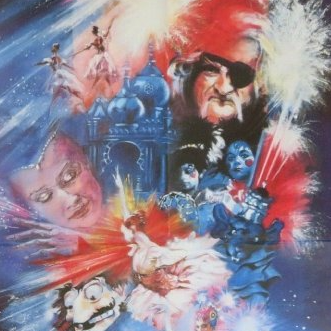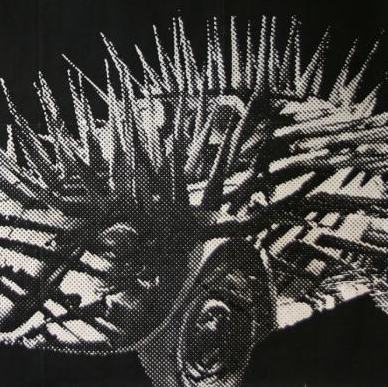Dream Demon
O.K., but are we SURE it isn't really a conspiracy involving her father-in-law?

UK poster | Palace Pictures
1984 — UK
A PALACE production, presented by FILMSCREEN PRODUCTIONS and BRITISH SCREEN in association with SPECTRAFILM
Cast: KATHLEEN WILHOITE and JEMMA REDGRAVE, with TIMOTHY SPALL, JIMMY NAIL, SUSAN FLEETWOOD, MARK GREENSTREET, ANNABELLE LANYON and NICKOLAS GRACE
Director: HARLEY COKELISS*
Producer: PAUL WEBSTER
Executive producers: JONATHAN OLSBERG, NIK POWELL, PETER WATSON-WOOD and TIMOTHY WOOLFORD
Screenplay: CHRISTOPHER WICKING and HARLEY COKELISS
Editors: IAN CRAFFORD and DAVID MARTIN
Cinematography: IAN WILSON
Production design: HUGO LUCZYC-WYHOWSKI
Art director: MALCOLM STONE
Costumes: SUE BLANE
Music: BILL NELSON
© National Film Trustee Company Ltd
* The film actually credits him as 'Harley Cokliss', without the 'e'. This spelling is consistent throughout the film and contemporary marketing materials, as well as the majority of his films that predate this one. However marketing materials for re-releases as well as the man's own website spell it with with an 'e', 'Cokeliss', so that's the one I've gone with here. IMDB suggests that this was the last thing where he was credited sans the 'e' in the middle of his name.
Ordinarily I would use the original trailer, but the only version I could find was at a rather low resolution, so this is the one for Arrow's release of the new fangled Director's Cut. Aside from the Arrow logo at the start, it's actually pretty similar, even using the same audio, though a couple of the shots are different and it removes some of the footage (mostly of Spall and Nail's characters) making it shorter overall. Apparently while they found the negative to the film itself, the trailer wasn't amongst the material, thereby necessitating a recreation, I guess.
A Sloane Ranger is about to embark on a marriage to a man from a well-respected family, much beloved by the patriotic masses for… reasons, but who may not be as entirely honourable as he tries to present. The press fucking hates her. See if you can tell where this is going.
Diana Markham (Jemma Redgrave) is a nursery school teacher from a well-heeled upper middle-class family. She’s all set to marry aristocrat and RAF man, Fl. Lt. Oliver Hall (Mark Greenstreet), a ‘hero’ of the Falklands. To what end is kind of vague, aside from, you know, causing a lot of death (that isn’t me editorialising, it’s outright stated that he done killed a whole load of people); the RAF played a relatively minor role in the war, due to a lack of places to actually base planes in the area. Regardless, he apparently wears his service dress all the damn time, so you know he’s a type. Well, anyway, that’s by the by, as Diana is having the jitters. Specifically in the form of dreams about things not going right, in various senses of the phrase ‘not going right’, involving her husband-to-be being increasingly beastly and violent. This is apparently perfectly normal, she’s told, despite her scepticism, and Daddy’s already bought her a fancy flat as an early present for her matrimonial life in a somewhat spooky house (actually he’s apparently bought the whole property, but has only deigned to give her a flat because it’s the ‘80s and there’s profit to be had, I guess), so everything’s well and moving into said house surely won’t have any effect whatsoever on her dreams. Her anxiety is not helped by the arrival of a tabloid hack, Paul (Jimmy Nail), and his sleazy photographer, Peck (Timothy Spall), who accost her and give her the third degree at every available opportunity, full of insinuation and innuendo about her person. She manages to be saved from them by Jenny (Kathleen Wilhoite), an American woman who’s come to see the house; apparently, she’s has learned that she was adopted, and managed to trace her biological parents to this house, but now it seems the trail’s gone cold. That night, the paparazzo breaks into the house for a snoop and some light theft, because the public has a right to know and all that, but it takes a sour turn when Diana notices something’s amiss (her engagement ring, for one thing); he takes the opportunity to harass her, the ring in exchange for what he wants, but his behaviour gets increasingly aggressive. Diana escapes, but the only place to flee to is the basement, which seems to have turned into a hellish pit. Things are looking bleak for our heroine, when a fiery apparition, running about in hysterics (as one does when on fire) manages to knock him into the pit, and then she wakes up. Her relief is short lived, her engagement ring is still missing… oh, yeah, and so’s Peck, but who cares about him? Other than his partner-in-crime who’s snooping around increasingly menacingly, that is.
In 1984, Palace licensed UK distribution rights for A Nightmare on Elm Street, New Line not having an established output deal with a UK distributor at that point in time. At the same time, they were starting to get into producing their own films, starting with The Company of Wolves (1984). While they’d enjoyed success by licensing some rather eclectic titles; their initial two reportedly being Diva and The Evil Dead (both 1981), suggesting their interest in artiness and exploitation, rather than one or the other; within a few years, bigger companies had cottoned on to this and started bidding on the sort of offbeat titles that were Palace’s bread-and-butter. The other thing was that they were one of the first companies in the UK to embrace the video market, licensing a lot of both old (such as Eraserhead (1977) and Pink Flamingos (1972)) and new titles (such as An Unsuitable Job for a Woman (1981) and Angel (1982)), and controversially releasing a lot of said films on video at nigh the same time as the cinema, even ones like the aforementioned two that they didn’t handle the theatrical releases of. Suffice to say, this strategy also fell apart a bit when the bigger companies got aboard the home video train. This is all a long-winded way of saying that making their own productions rather than trying to nab rights to existing films was an increasingly attractive proposition, and despite securing Nightmare on Elm Street (and later three of its sequels) they were apparently confident enough in its potential that they pretty much immediately decided to develop a knock-off. Except it took quite a while to get off the ground and pretty soon drifted away from its source. I assume the title is a hangover from the early days that someone was particularly attached to when it was, presumably, supposed to be more slashery, as if you’re watching the film and waiting for some kind of Dream Demon to turn up, you’re probably going to be disappointed. Not least because the big gore money shot is front loaded, à la Scanners.
No, no, instead it morphed into some kind of satire on Princess Di’s treatment by the media. Even ignoring Jemma Redgrave’s character’s name, they rather lean into it; German marketing materials have the rather to the point catchcopy ‘Die Horrorträume der Lady Di’ even. On the off-chance that any young people are reading (HA!), it might seem hard to believe now, as they started treating her like a saint the moment she died, but good god while she was alive the press was all about laying into the woman regardless of what she did. I was a child at the time, but even I was aware of both their apparent disdain for her as well as of their complete volte-face when she died. Also it seems like we stopped talking about their role in that quite quickly. I’d say ‘the more things change, the more they stay the same’, but that would imply that there was any change.
The Diana allegory shift apparently happened quite early on. It makes a degree of sense that they shifted away from slasher territory; supposedly† the original pass was co-written and intended to be directed by Christopher Petit, perhaps as another stab at the mainstream following An Unsuitable Job for a Woman’s box office failure. That film essentially ended up as a ghost story without the ghost, less a detective story and more of a disconcerting state-of-the-nation piece (seemingly raising the ire of the novel’s fan base), so it would perhaps follow that an actual horror film would as well. True to form, that fell through, so there was a new director, more revisions, this apparently shifted away from the reportedly more cerebral tone to something more conventionally horrific and grisly, before this fell through again, resulting in this version directed by Harley Cokeliss (perhaps best known in the UK, weirdly, for a bunch of Children’s Film Foundation films, most notably fan favourite The Glitterball (1977)) from a draft by Hammer and AIP veteran Christopher Wicking (he did Scream and Scream Again (1970), Blood from the Mummy’s Tomb (1971) and Demons of the Mind (1972)) which tried to shift it back to something more cerebral; Cokeliss for his part seemed to imagine it, no joke, as Céline and Julie Go Boating (1974) as a horror movie, which, again no joke, actually makes increasingly more sense the more I think about it. The result is however, suffice to say, kind of a mishmash that doesn’t always come together as it should.
So… the idea is that the prim Diana is haunted by her unknown future and the brash Jenny is haunted by her forgotten past and two are intrinsically intertwined in this creepy house that evidently holds some kind of dark secret. That’s fine and dandy, but it doesn’t really combine the two all that well. Certainly, the iconography and that for Diana’s anxieties are largely discarded in the second act; her awful fiancé as the representation of her fears pretty much disappears from the dream world (he still crops up in reality), superseded by Nail and Spall’s muckrakers becoming increasingly bestial and monstrous. I suppose within the logic of the plot as it develops, such as it is, it would be difficult to maintain him as the face of her anxiety given as he’s required for actions in the ‘reality’ of the film, but the shift in gears is jarring and inelegant, and makes it more difficult to connect the blurring of the different dreamworlds. I suppose that side of it is somewhat secondary. In a Guardian article from around the time of the film’s release, it’s purported that Cokeliss was applying Billy Wilder’s axiom that “in movies logic isn’t important but emotion is” (Minson), and certainly the film does have a fairly palpable sense of emotion to proceedings, even if the sense of what fears are the characters are confronting isn’t as clear as it necessarily should be.
The film’s ability to impart emotions onto the audience is down in no small part to its sumptuous visuals. Shot on a low budget (reportedly £2m), the film nevertheless has an impressive sense of style and atmosphere, seldom looking as cheap as it apparently is. This was seemingly achieved by relying heavily on old time German Expressionist era techniques to accomplish the myriad effects required, meaning pretty much everything was done live in camera rather than in post, utilising smoke and mirrors quite literally. And so there’s a lot of uses of things like two way mirrors, double exposures, changes in shutter times, and at least one scene shot entirely in reverse. This is complemented by some increasingly abstract production design as the characters drift further and further away from objective reality into realms of light and shadow that are part The Cabinet of Dr Caligari (1920), part Suspiria (1977).
The film was borderline lost for ages due to essentially all the companies involved going under in fairly rapid succession not all that long after its release. Cokeliss had apparently been on an on-again-off-again hunt for the elements, and also whoever ended up with the rights to the thing in the end, to do a proper restoration for a while. (Apparently, it’s the BFI, by the way.) This leads to the elephant in the room I suppose I have to address this is the recent restoration’s Director’s Cut, though really there’s not that much to say about it. It’s only controversial, near as I can tell, because he removed some footage, specifically about a minute of the denouement. This is, in fact, the only difference. I’m loath to talk about it too much due to its position in the film, but the meat of it is that the theatrical cut had a comic coda that’s been cut out. Cokeliss explains his rationale by saying that while he liked the scene, it seemed like an inappropriate note to end the film on as it takes focus away from the two women. Frankly I’m inclined to agree. There’s actually a little more changed that just that removal, but then we’re getting into proper spoiler territory. Still, I can see why some people might prefer the original (I mean, legitimately, rather than just going ‘it’s longer so it must be better’); it wraps up another loose end rather than essentially introducing another one. (Though really it was a loose end I didn’t really care that much about seeing resolved.)
† As in ‘the furthest I’ve been able to trace this claim is to the Horror volume of The Aurum Film Encyclopedia’, evidently at least the second edition, as the first predates the film. Quite where they got it from, I don’t know; I don’t have a copy of the book and the snippets on Google Books aren’t particularly illuminating; though most of the new entries in the second edition were reportedly by Kim Newman who tends to know this sort of stuff. That said, it doesn’t seem to get mentioned by the producer in interviews. Petit does however get a ‘development executive’ credit in the film itself, whatever that means.
At time of writing, Dream Demon is available to rent off of Amazon, Youtube, and the BFI Player, amongst other services. It's also available to stream via both Arrow's own service and their sub-channel on Amazon. I recommend JustWatch for keeping up with where films are streaming (including this one!). Alternatively, physical copies are reportedly available for rent via Cinema Paradiso.
The film presently has a 15 rating (last submitted in 2020), the BBFC citing “strong bloody violence, threat, domestic abuse, [and] nudity”. This is down from an 18, which it previously had.
Sources
Cunliffe, M., 2021. ''Dream Demon' (1988) revisited', We Are Cult. [online] Available at: <http://wearecult.rocks/dream-demon-1988-revisited> (Accessed 10 June 2021).
Hardy, P., ed., 1993. The Aurum Film Encyclopedia: Horror (2nd Edition). London: Aurum Press.
Minson, J., 1988. ‘It’s all done with mirrors’, The Guardian, 13 Oct. p.23a.
Wickham, P., and Mettler, E., 2005. Back to the Future: The fall and rise of the British film industry in the 1980s – An information briefing. [PDF] London: BFI National Library. Available at: <https://www2.bfi.org.uk/sites/bfi.org.uk/files/downloads/bfi-back-to-the-future-the-fall-and-rise-of-the-british-film-industry-in-the-1980s.pdf> (Accessed 12 June 2021).



